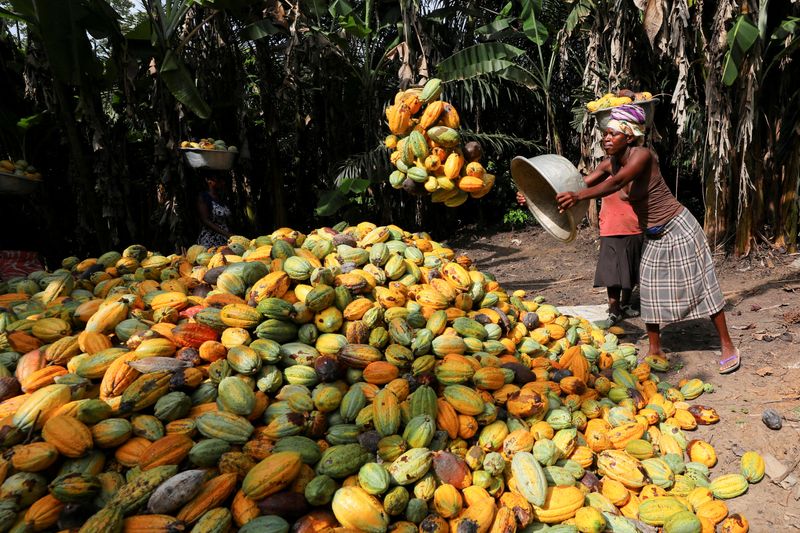By Naveen Thukral and Florence Tan
SINGAPORE (Reuters) – Cocoa and coffee are poised to close 2024 as the biggest gainers among commodities for a second year on a global supply deficit, while steel-making coal will end as the worst performer, hit by slow growth in China.
Looking ahead, global trade tensions are likely to dominate the commodities landscape in 2025 as Donald Trump returns to the White House threatening hefty tariffs, analysts said.
A strong dollar and gold’s appeal as a safe haven for investors are likely to support precious metals prices, while ample supply could depress oil for a third year, they added.
In bad news for chocolate lovers, cocoa nearly tripled in price over 2024, far outpacing gains in other commodities. It hit a record high of $12,931 a metric ton in New York earlier this month on forecasts of lower supply for a fourth successive season in West Africa following dry weather.
“The softs sector, led by cocoa and coffee, has been the main winner amid adverse weather in key growing regions, highlighting the risk to prices when products like these are produced and sourced from relatively small geographical areas,” said Ole Hansen, head of commodity strategy at Saxo Bank in Copenhagen.
Top cocoa producers Ivory Coast and Ghana have suffered crop losses due to adverse weather, bean disease, smuggling and reduced plantations in favour of illegal gold mining.
Dryness has strained coffee supplies as well. ICE Arabica coffee prices soared to their highest in more than 40 years amid fears that severe drought earlier this year damaged the upcoming crop in top producer Brazil.
CHINA GROWTH WORRIES HIT OIL, IRON ORE
Crude oil and bulk metals faced headwinds in 2024 as China, the world’s second-biggest economy and top commodities buyer, struggled mainly due to a property crisis.
Brent and West Texas Intermediate crude could post a third consecutive annual decline in 2025 as supply outstrips a rebound in demand growth, analysts said, although Trump’s policies on major producers Russia and Iran could curb supply.
Spare capacity in the Organization of the Petroleum Exporting Countries (OPEC) reached an unprecedented 5 million barrels per day (bpd), analysts estimated, with the group having extended production cuts to March.
“The bleak inventory path next year suggests that OPEC+ will be challenged to bring back barrels into the market,” Harry Tchilinguirian, head of research at Onyx Capital Group, said in a note.
Iron ore prices in China recouped some losses in recent months but are still headed for a 15% decline in 2024. Prices could fall again next year as iron ore supply grows and Chinese steel demand falls, analysts said, despite Beijing’s stimulus measures.
“We expect the increase in iron ore supply from major miners will be higher than that in 2024, but steel output in China will likely slide,” Pei Hao, senior analyst at brokerage Freight Investor Services, said, forecasting an average price of $100 a ton in 2025, down from an average of $110 in 2024.
Gold and silver rose more than 25% in 2024 and could climb further in the year ahead depending on the U.S. Federal Reserve’s interest rate cuts and Trump’s tariff, tax and foreign policies, analysts said.
“Gold is the standout for us in 2025,” ING’s head of commodity research Warren Patterson said, adding that strong gold purchases by central banks will support demand.
Copper and aluminium prices are set to end 2024 higher, driven by tight supplies, the energy transition and hopes that China’s stimulus measures will boost demand.
PALM OIL, RUBBER AND GRAINS
For agricultural products, Malaysian palm oil futures jumped around 20% in 2024, snapping two consecutive years of losses, lifted by Indonesia’s biodiesel mandate and adverse weather in Indonesia and Malaysia.
Crop-threatening weather also drove a 42% gain in Tokyo rubber futures.
In contrast, soybeans, corn and wheat were in plentiful supply, all on track for losses in 2024. However, wheat prices could find some support in 2025 as warmer weather in Russia, the biggest exporter, threatens to reduce output.
Top soybean exporter Brazil is poised to deliver record supplies in 2025, positioning it to meet a rise in Chinese demand if a Washington-Beijing trade war erupts.

